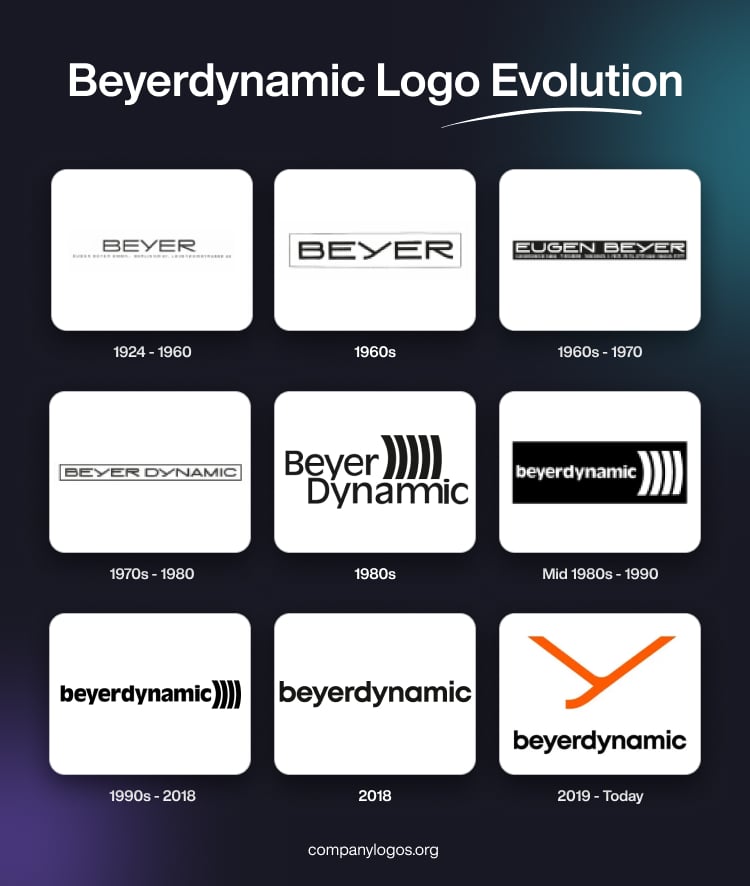
Beyerdynamic is a renowned German audio equipment manufacturer known for its precision-engineered headphones, microphones, and conference systems. It was founded in 1924 by Eugen Beyer in Berlin. In the initial period, the company used to produce cinema loudspeakers during the early days of sound film.
Over the years, the company introduced iconic products, such as the DT 48 (1937), the world’s first dynamic headphone, and the M 160 ribbon microphone. In no time, Beyerdynamic set industry benchmarks for clarity, durability, and acoustic fidelity. It evolved into one of the most respected names in professional and consumer audio.
The company logo has undergone a few changes since its introduction in 1924. It began with a straightforward text of the founder’s name to stylised product-era emblems. The article delves into the evolution of the Beyerdynamic logo, among other details of the company.
The Genesis of the Beyerdynamic Logo (1924 – 1960)
The original logo depicted the wordmark “BEYER” in a thin, geometric sans-serif typeface in grey. The letter “Y” is characterised by its wide vertical bars, and the overall logo did not feature any graphical element.

(1960s)
The 1960 iteration featured the wordmark “BEYER” in a bold and black avatar of its previous form. It was enclosed within a horizontal-oriented rectangle with a thin outline.

(1960s – 1970)
The 1960 logo featured the full name of its founder “EUGEN BEYER”, in white against a black rectangular background.

(1970s – 1980)
The next logo iteration of 1970 showed the company name that exists today, “BEYER DYNAMIC”. The name was enclosed within a rectangular frame with a thin outline. The wide geometric letters of a sans-serif typeface reflected the style of the previous wordmarks.

(1980s)
The 1980 logo was a bit different from the previous iterations. It featured the company at two levels in a sans-serif typeface. Depicted in a title case, the word “Beyer” was followed by four closed parentheses in black, depicting the propagation of sound waves. The wordmark “Dynamic” was written below and was slightly aligned to the right.

(Mid 1980s – 1990)
In the mid-1980s, the logo featured the company name “beyerdynamic” in white and in a single line in lowercase. It was followed by the parenthesis in white. The overall logo was set against a black rectangular background.

(1990s – 2018)
In the beginning of the 1990s, the logo was almost the replica of the previous version, but with the colour palette reversed.

(2018)
The 2018 logo did away with the graphical element and depicted only the wordmark “beyerdynamic” in a minimalist, geometric sans-serif typeface in black.

(2019 – Today)
The current logo was introduced in 2018 as part of a rebrand, and it featured a sleek, minimalist, and lowercase wordmark in a new sans-serif typeface called MONT in shades of grey and black. Alongside the wordmark appears the graphical “Y” signet in orange, where it symbolises the values and legacy of the company.


The Elements of the Beyerdynamic Logo
Font
The current Beyerdynamic logo uses a custom geometric sans-serif typeface inspired by MONT, designed by Fontfabric. The clean, minimalist typeface in lowercase represents modernity, accessibility, and the company’s focus on innovation. Besides, the rounded letterforms and uniform stroke width convey precision and balance.
Colour
The Beyerdynamic logo is designed using a refined colour palette featuring neutral greys, black, and a vibrant accent orange. The orange accent serves as a visual highlight in marketing materials and digital interfaces and represents creativity, energy, and emotional connection with sound.
The History of Beyerdynamic
Beyerdynamic is one of the world’s oldest and most respected audio equipment manufacturers. It was founded in 1924 by Eugen Beyer in Berlin, Germany, under the name Elektrotechnische Fabrik Eugen Beyer. Initially, it specialised in developing cinema loudspeakers for the emerging era of “talking pictures”. The first products from Beyerdynamic brought clear, high-quality audio to German cinemas. This marked the beginning of the brand’s long-standing pursuit of acoustic excellence.
In 1937, Beyerdynamic achieved a groundbreaking milestone with the launch of the DT 48, the world’s first dynamic headphone. The design of this product was so advanced and reliable that it remained in production for decades. This invention established Beyerdynamic’s reputation as a pioneer in audio engineering. During the 1950s, the company expanded into microphone technology and introduced iconic models like the M 19 and M 160. These became widely used in broadcasting and recording studios.
After the Second World War, Beyerdynamic relocated its operations from Berlin to Heilbronn, where it remains till today. In the postwar years, the company’s products gained international recognition, with Beyerdynamic microphones used during significant global events, such as the 1966 FIFA World Cup and the Beatles’ 1966 German tour.
Over the seventies and eighties, Beyerdynamic continued to innovate. It produced high-fidelity studio headphones and wireless microphone systems that became industry standards. The DT 770, DT 880, and DT 990 series, which were introduced in the 1980s, established Beyerdynamic as a leader in studio monitoring. These remain among the most popular reference headphones today.
In the 2000s and 2010s, the company embraced digital technology while preserving its hand-crafted German engineering tradition. Beyerdynamic introduced products such as the Tesla driver technology to enhance efficiency and sound accuracy. In 2018, it underwent a major rebrand, wherein it unveiled a new lowercase wordmark, modern font, and the iconic “Y” signet. These were introduced to symbolise the legacy of its founder as well as a step toward a new era of innovation.
Beyerdynamic remains a family-owned company and is managed by the third generation of the Beyer family. It continues to produce all its high-end audio equipment in Germany and upholds a near-century-old tradition of craftsmanship. So, the history of Beyerdynamic reflects its enduring commitment to engineering excellence and pure sound reproduction.
Interesting Facts About Beyerdynamic
- Beyerdynamic was founded in 1924 in Berlin by Eugen Beyer, who started by manufacturing loudspeakers for silent cinemas. This marked the beginning of the company’s long history in audio technology.
- The company launched its first headphones, the DT 48, in 1937. These were the world’s first mass-produced dynamic headphones and remained part of the product lineup until 2012. This aspect makes them one of the longest-lasting consumer audio products in history.
- In 1939, Beyerdynamic introduced the M 19 microphone, which became the first studio-quality dynamic microphone. This became historically significant as well for becoming the reporting microphone for German national broadcasting.
- The company was destroyed during the Second World War and relocated to Heilbronn in 1948, where it rebuilt its factory and expanded production.
- In 1959, the company was taken over by the 26-year-old Fred R. Beyer, the son of the founder, Eugen Beyer. He managed the company for the next four decades and guided it through numerous innovations.
- Beyerdynamic pioneered several audio technologies. These included highly directional ribbon microphones, wireless microphones starting in the early 1960s, and digital conference systems in the 1990s.
- The company remained family-owned for over 100 years until 2025, when it was acquired by a Chinese firm.
- Beyerdynamic products have been used by famous musicians and at major events. These included the Beatles, Elton John, ABBA, Stevie Wonder, and the 1988 Seoul Olympics media coverage.
- Many Beyerdynamic products are still handcrafted in Heilbronn, which emphasises meticulous German craftsmanship and quality.
Finally
The Beyerdynamic logo and its various iterations are a visual journey that reflects the company’s continuous innovation and enduring respect for its heritage. Thus, what began as straightforward wordmarks in the 1920s to emphasise the founder’s name and technical craftsmanship transformed into the bold introduction of the sound-wave emblem in the late 20th century. Each logo design shows the brand’s growth and expanding influence in professional audio.